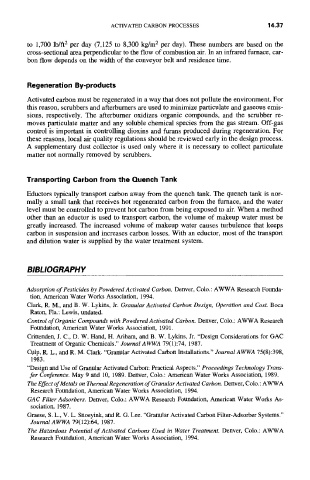Page 489 -
P. 489
ACTIVATED CARBON PROCESSES 14.37
to 1,700 lb/ft 2 per day (7,125 to 8,300 kg/m 2 per day). These numbers are based on the
cross-sectional area perpendicular to the flow of combustion air. In an infrared furnace, car-
bon flow depends on the width of the conveyor belt and residence time.
Regeneration By-products
Activated carbon must be regenerated in a way that does not pollute the environment. For
this reason, scrubbers and afterburners are used to minimize particulate and gaseous emis-
sions, respectively. The afterburner oxidizes organic compounds, and the scrubber re-
moves particulate matter and any soluble chemical species from the gas stream. Off-gas
control is important in controlling dioxins and furans produced during regeneration. For
these reasons, local air quality regulations should be reviewed early in the design process.
A supplementary dust collector is used only where it is necessary to collect particulate
matter not normally removed by scrubbers.
Transporting Carbon from the Quench Tank
Eductors typically transport carbon away from the quench tank. The quench tank is nor-
mally a small tank that receives hot regenerated carbon from the furnace, and the water
level must be controlled to prevent hot carbon from being exposed to air. When a method
other than an eductor is used to transport carbon, the volume of makeup water must be
greatly increased. The increased volume of makeup water causes turbulence that keeps
carbon in suspension and increases carbon losses. With an eductor, most of the transport
and dilution water is supplied by the water treatment system.
BIBLIOGRAPHY
Adsorption of Pesticides by Powdered Activated Carbon. Denver, Colo.: AWWA Research Founda-
tion, American Water Works Association, 1994.
Clark, R. M., and B. W. Lykins, Jr. Granular Activated Carbon Design, Operation and Cost. Boca
Raton, Fla.: Lewis, undated.
Control of Organic Compounds with Powdered Activated Carbon. Denver, Colo.: AWWA Research
Foundation, American Water Works Association, 1991.
Crittenden, J. C., D. W. Hand, H. Ariham, and B. W. Lykins, Jr. "Design Considerations for GAC
Treatment of Organic Chemicals." Journal AWWA 79(1):74, 1987.
Culp, R. L., and R. M. Clark. "Granular Activated Carbon Installations." Journal AWWA 75(8):398,
1983.
"Design and Use of Granular Activated Carbon: Practical Aspects." Proceedings Technology Trans-
fer Conference. May 9 and 10, 1989. Denver, Colo.: American Water Works Association, 1989.
The Effect of Metals on Thermal Regeneration of Granular Activated Carbon. Denver, Colo.: AWWA
Research Foundation, American Water Works Association, 1994.
GAC Filter Adsorbers. Denver, Colo.: AWWA Research Foundation, American Water Works As-
sociation, 1987.
Graese, S. L., V. L. Snoeyink, and R. G. Lee. "Granular Activated Carbon Filter-Adsorber Systems."
Journal AWWA 79(12):64, 1987.
The Hazardous Potential of Activated Carbons Used in Water Treatment. Denver, Colo.: AWWA
Research Foundation, American Water Works Association, 1994.

